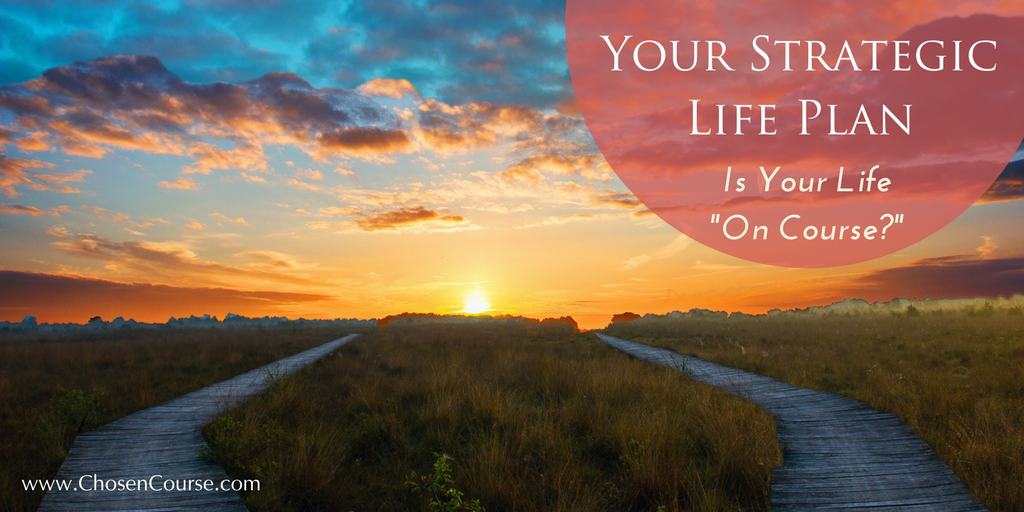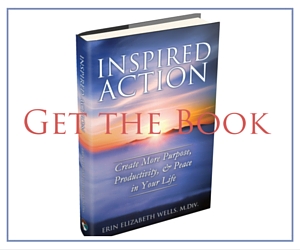Sometimes life is in the process of shifting dramatically, and it might be time to make sure that with such changes you life is still remaining “on course” with your vision and desires. Those are the times when it might be worth it to spend some time getting clear on your Strategic Life Plan which was the focus of one chapter of my book, Inspired Action: Create More Purpose, Productivity, and Peace in Your Life.
As a gift, I’ve excerpted that chapter here to help you think about whether you’re ready to create your Strategic Life Plan sometime soon. So, here it is, Chapter 47: Your Strategic Life Plan.
Your Strategic Life Plan
I knew that I needed to get away. It’s not that anything was particularly going wrong with my life. I had a career I enjoyed, was in a good relationship, and had a beautiful apartment overlooking a lake in a great neighborhood. Nothing was wrong per se, but I felt overwhelmed and confused. I had been losing focus and steam in my everyday life, and the activities that I normally jumped out of bed to do were beginning to feel like drudgery.
I knew that it was time to dig deep and really check in with myself and where I was going. It was time to adjust my strategic life plan and get my heart and focus back on course. At the time, I was living just outside Boston, and for years I had heard about a lovely little town on the North Shore called Rockport. I looked it up on a map and discovered that the town was about an hour from my home. Within 30 minutes, I had found a historic inn where I could get a room with a view of the ocean (and a hot tub), and I knew this was what I needed to do. So what that it was February and not quite the season for an ocean-side retreat!
It was the right decision—even with the biting February winds off the Atlantic. The retreat gave me time to rest and to review what was happening in my life. It allowed me to rediscover my passion and develop a plan for how to bring my life more into alignment with that passion every day. It was time for some big changes, but I knew that I could do them gradually over a few years rather than dramatically overnight.
What Is the Next Chapter of Your Strategic Life Plan?
I truly appreciate the metaphor that our lives are lived in chapters. A chapter is usually a set of years, like your time in college, the period when you worked at your first job, the time in your marriage before your kids, and your empty-nest but preretirement years. If we look back on our lives, usually the chapters become clear, and they are marked by significant transition events. Sometimes those events are foreseeable, but occasionally they are not. (After all, you didn’t see that health crisis or layoff coming, did you?)
If you reflect on your life right now, where are you in your current chapter? At the beginning, somewhere in the middle, or coming to the end? Often, people pick up a book like this one at the beginning or the end of a chapter as they look to redefine their focus for the next chapter that they know is coming (or that they are determined to create). Perhaps now is a time when you’re ready to step back and take some time to ask yourself the really big questions.
I began my book, Inspired Action, with an exploration of purpose and a guide to creating your life list and lifestyle list. If you have not yet picked up a copy, then you can learn more at www.InspiredActionBook.com.
Inspired Action has chapters that cover daily, weekly, seasonal, and yearly planning. However, our focus here is about your “life chapter” transition moments—or any moment when you find yourself wanting to choose a clear course for your life. You might bundle this process into your annual retreat every few years, or it might arise naturally as an instinct to step away from daily life, reflect, and recalibrate. These are the times when you step back and do a purpose and passion check.
As a guide through this experience, allow me to offer some suggestions and questions that can help you to create a space in which to find your best answers. You might also want to download the Strategic Life Plan eGuide to help guide you through this process.
Creating the Space
Reflection time is best when we give ourselves permission to truly step away from our current life routines, and that will require a little planning. Here are a few thoughts to help you get that planning started.
Block off a week. A week is my preference for these life-chapter reflection times, but it should be at minimum four days, to give yourself the time and space alone to do your inner work. I encourage a week or longer because in reality you’re unlikely to be able to dig deep for the first one to two days, while you unwind from the everyday and open up to the reflective work at hand. If you want to make it two or three weeks, then go for it!
Consider going away from home. Often a change of location can lead to clarity and possibilities that we cannot see from our usual vantage point. It doesn’t have to include getting on a plane and flying somewhere (although it might if you live in the Midwest and are craving a beautiful tropical beach.) As you saw in my story, I simply found a lovely inn within driving distance of my home. It was away from my usual stomping grounds but still within easy reach.
Take your reflection tools. Journal, capture book, master list, plenty of pens, inspirational reading, music that puts you into a reflective space, perhaps a sketchbook…take along any tools that can help you clarify and process your thoughts and feelings in this moment and bring into focus what you want to create in the next chapter.
Decide who could help you. While I often recommend experiencing these life-chapter retreats alone, you might feel strongly that you would benefit from having your partner or a close friend with you. Just make sure you’re clear with him or her that the trip is intended not as a vacation but as a reflection retreat, and make sure he or she is on board with participating in your process. Another solution can be to put your close friend or family member on alert that you might need to call while you’re away to process your thoughts and feelings. Then you can create brief pockets of togetherness and still have significant space alone.
What to Do When You Get There
I encourage you to listen to your instincts about how you will structure your time. Here are some ideas if you feel you need further guidance.
On arrival day. Take some time to get grounded in your space. Unpack your luggage, explore the space you have chosen, find a seat with a great view, and just breathe and observe the world. Talk to the concierge, the front-desk clerk, or someone local about great local restaurants—since you will have to eat on this trip and having excellent nourishment and beautiful atmospheres will definitely support your reflection work. If you prefer, check Yelp and bookmark some good restaurant options.
When you’re beginning to feel more grounded in this place, take a few moments to pause and set your intention for this experience. You can think it and send it out to the universe as energy, meditate on it, write it in your capture tool, or say it aloud. Make it a positive statement about what you intend to have or create while you’re here. This moment essentially begins your ritual experience and starts your reflective ball rolling. While you might choose to do activities that are purely for the joy of the experience on this trip, you are making it clear to the universe that you are open and looking for insights about how to focus the next chapter of your life.
During the middle days. These are your good “work” and reflection days. Listen to your energy. Do you want to take a walk someplace beautiful? Read an inspirational book? Write in your journal? Brainstorm new items for your life list? You’ll find a rhythm and a pattern that is innately yours. Just open yourself and trust that in each of those activities, the insights you need to move forward will arise.
When you’re ready, it’s time to write a vision for your life. What do you want to create for yourself? To help you get focused on your inner work, here is a set of questions to guide your reflections and develop your vision:
- Do you have a purpose statement? If so, what is it? Does your purpose statement still feel like it fits? (Read Chapters 1 and 6 for help.) Is it time to redirect, refine, or focus more deeply on a particular area, or is it time to shift directions entirely?
- What might be the major attributes, activities, or life milestones during the next three to five years of your life?
- Which key elements of your current life chapter do you want to continue in the next one?
- Do you have any dreams or experiences from any previous chapter that you are now ready to fulfill?
- What are your major goals in each of these areas: finances, career, fun/recreation, health, relationships, personal life, and your life legacy? Aim for one to three goals in each area.
- Are there experiences that you are now ready to leave behind to start this new chapter fresh and feeling empowered? What healing and forgiving needs to happen in order for you to leave them behind?
- How could you live each day to its fullest and know that if this chapter were your last, you would have no regrets?
Answering these questions will give you a much clearer vision of the life that you want to create in the next few years. Having that vision will allow you to manifest it.
If you’d like an eGuide to walk you through these questions and more to develop your Strategic Life Plan, then you can get one to download here:
On your final day(s). Now would be a great time to write or update your strategic life plan. Just as businesses have strategic plans to guide their focus and development, I believe we all can have a plan to help guide our lives. Will it change? Might you go off course? Absolutely!
Did you know that the Apollo 11 astronauts on their way to the moon were “on course” only 3 percent of the time? They were making constant course corrections.
The point of having a plan is to define where you intend to go. You can never be on course if you don’t have a defined destination. Living life without a plan is simply meandering rudderless. It means consistently wasting this beautiful opportunity to live, learn, and give to
those around you. Your strategic plan can focus on the intention, energy, and outcomes
you want to create for the next three to five years—i.e., your next chapter. Look at the goals you identified in question 5 above. Can you choose or identify where your focus needs to be in year one, two, or three in order to accomplish each one? This is your chance to break big goals down into smaller milestones. While you might include visions of the horizons and years beyond, most of your attention should stay on this upcoming chapter. Make sure to slot items from your life list into your strategic plan as well. This is how you ensure that they happen instead of remaining a perpetual “maybe someday.”
You can download an eGuide to help you create your first strategic life plan here.
When you have come to the end of your life-chapter retreat, make sure you spend a few moments in gratitude. Make a list of all the things in your life for which you are currently grateful. I challenge you to think of at least 100.
Next Actions
- Make your strategic life plan a lived daily experience and a focus tool. This is not something to bury in a drawer and forget. For some strategies to keep your goals active and alive, read (or reread) Inspired Action – Chapter 10: Vision the Possibilities, Then Make Them Manifest.
- Share your strategic life plan with a close friend, family member, or partner. Ask him or her to help you bring your plan into action, or at least cheer you on as you do. If you have a life partner, then you might want to work together to create some goals on your plan so that you are moving forward collaboratively.
- Celebrate every goal you achieve! There’s nothing like a good celebration to share your gratitude with the universe and prepare it to send you more of what you want.



